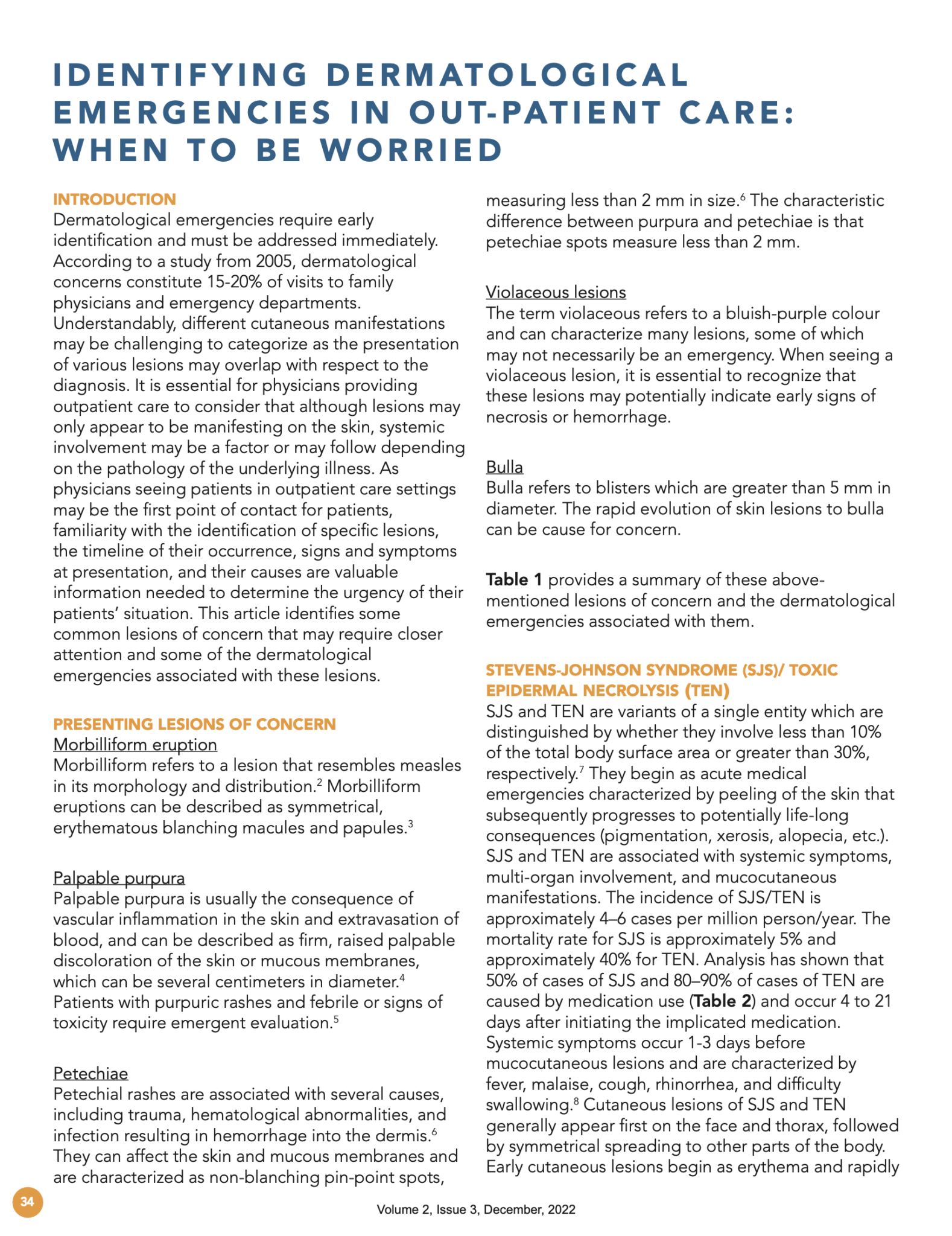Identifying Dermatological Emergencies in Out-Patient Care: When to be Worried
DOI:
https://doi.org/10.58931/cait.2022.2338Abstract
Dermatological emergencies require early identification and must be addressed immediately. According to a study from 2005, dermatological concerns constitute 15-20% of visits to family physicians and emergency departments. Understandably, different cutaneous manifestations may be challenging to categorize as the presentation of various lesions may overlap with respect to the diagnosis. It is essential for physicians providing outpatient care to consider that although lesions may only appear to be manifesting on the skin, systemic involvement may be a factor or may follow depending on the pathology of the underlying illness. As physicians seeing patients in outpatient care settings may be the first point of contact for patients, familiarity with the identification of specific lesions, the timeline of their occurrence, signs and symptoms at presentation, and their causes are valuable information needed to determine the urgency of their patients’ situation. This article identifies some common lesions of concern that may require closer attention and some of the dermatological emergencies associated with these lesions.
References
Freiman, A., Borsuk, D. & Sasseville, D. Dermatologic emergencies. CMAJ 173, 1317–1319 (2005).
Drug rashes. 282–291 (Elsevier, 2022).
Haber, J. S., Cipriano, S. D. & Oza, V. S. Morbilliform Eruptions in the Hospitalized Child. Dermatol. Clin. 40, 191–202 (2022).
Purpura. in Principles and Practice of Pediatric Infectious Disease 446–448 (W.B. Saunders, 2008).
Heather Murphy-Lavoie, T. L. L. Approach to the Adult Rash. in Emergency Medicine 2nd Edition (ed. Adams, J. G.) 1598–1608 (Elsevier Inc., 2013).
McGrath, A. & Barrett, M. J. Petechiae. in StatPearls [Internet] (StatPearls Publishing, 2021).
Cardon, Z. E., Kaide, C. G. & Bischof, J. J. Stevens Johnson syndrome – ‘Steven who? And why I should care about his Johnson?’ in Case Studies in Emergency Medicine 547–558 (Springer International Publishing, 2020).
Eginli, A., Shah, K., Watkins, C. & Krishnaswamy, G. Stevens-Johnson syndrome and toxic epidermal necrolysis. Ann. Allergy Asthma Immunol. 118, 143–147 (2017).
Oakley, A. M. & Krishnamurthy, K. Stevens Johnson Syndrome. in StatPearls [Internet] (StatPearls Publishing, 2021).
Shiohara, T. & Mizukawa, Y. Drug-induced hypersensitivity syndrome (DiHS)/drug reaction with eosinophilia and systemic symptoms (DRESS): An update in 2019. Allergol. Int. 68, 301–308 (2019).
Jeung, Y.-J., Lee, J.-Y., Oh, M.-J., Choi, D.-C. & Lee, B.-J. Comparison of the causes and clinical features of drug rash with eosinophilia and systemic symptoms and stevens-johnson syndrome. Allergy Asthma Immunol. Res. 2, 123–126 (2010).
Cohn, A. & MacNeil, J. The Changing Epidemiology of Meningococcal Disease. Infect. Dis. Clin. North Am. 29, 667–677 (2015).
Misiakos, E. P. et al. Current concepts in the management of necrotizing fasciitis. Front Surg 1, 36 (2014).
Kiat, H. J., En Natalie, Y. H. & Fatimah, L. Necrotizing Fasciitis: How Reliable are the Cutaneous Signs? J. Emerg. Trauma Shock 10, 205–210 (2017).
Machado, N. Necrotizing fasciitis: The importance of early diagnosis, prompt surgical debridement and adjuvant therapy. N. Am. J. Med. Sci. 107–118 (2011).
Fitzpatrick, J. E. & High, W. A. Urgent Care Dermatology: Symptom-Based Diagnosis. (Elsevier Health Sciences, 2017).
Woolum, J. A., Bailey, A. M., Baum, R. A. & Metts, E. L. A Review of the Management of Stevens-Johnson Syndrome and Toxic Epidermal Necrolysis. Adv. Emerg. Nurs. J. 41, 56–64 (2019).

